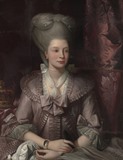
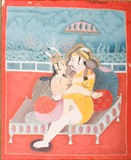
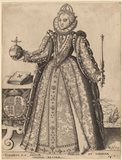
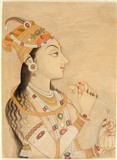
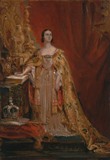
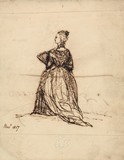
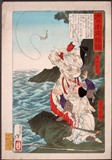
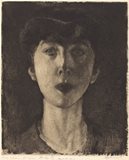
Two large works
Images below are in chronological order and sized approximately to scale relative to each other. *Click images to enlarge*
1. Queen Charlotte
Artist: Benjamin West, age 39 (American; born 1738, died 1820)
Medium: Oil on canvas, 36 x 28 inches
Location: Painted in London
Time: Painted in 1777, during the American War of Independence from the British. West was an American expatriate in London and history painter to King George III at the time. West's sympathy with the American cause didn't affect his friendship with the king.
Woman subject: Upon his accession to the throne, George III was anxious to marry. He asked his advisor to identify suitable German Protestant princesses, among them Charlotte Sophia of Mecklenburg-Stelitz. George and Charlotte ended up having fifteen children together. George began suffering intermittently from mental illness in 1788 and was finally removed from the throne in 1811 into Charlotte's care. Charlotte is 32 years old in this portrait.
Things to notice: Notice the structured composition; West painted in the Neoclassical style. The gold accents on the pillow trim, the crown, and the bracelets form a triangle, as do the three bows of the queen's dress. The portrait is visually divided into thirds by Charlotte's head and impressive hairdo, the central bow of her dress, and her gracefully posed hands. West's attention to detail creates illusionistic texture.
2. Emperor Jahangir (reigned 1605-1627) and Empress Nur Jahan in union
*Gender of artist is unknown*
Artist: Artist unknown (Nepalese)
Medium: Drawing, opaque watercolor, gold, and silver on paper, 27 x 23 inches
Location: Made in Nepal
Time: Made in about 1830, toward the end of Nepal's rule by the Gorkha kings. The Gorkhas were descended from the kings of Rajasthan in India. The Mughal dynasty in India was also drawing to a close.
Woman subject: The Mughal emperor Jahangir ruled India from 1605 to 1627. He married the Persian widow Mehrunissa and renamed her Nūr Jāhān ("light of the world") in 1611, when she was 34 years old. Their deep love for one another meant that Nūr Jāhān had a lot of influence upon Jahangir's decisions. She effectively ruled India during the last five years of Jahangir's life due to the emperor's failing health. Nūr Jāhān's daughter from her previous marriage married one of Jahangir's sons, but Jahangir preferred a different son as successor. Nūr Jāhān schemed to promote her son-in-law to the throne but was unsuccessful.
Things to notice: This is likely an illustration for a large folio manuscript. Bright, contrasting colors are typical of Nepalese painting. The subject matter for Nepalese picture books during the 19th century shows the influence of Indian erotica. Throughout history, Indian art has explored sensual and erotic subjects, sometimes illustrating themes of sexuality in the Kāma Sūtra. The red on Nūr Jāhān's fingertips, toes, and the edge of her foot are part of her beautifying makeup. Notice the turban worn by Jahangir and the topi-like hat worn by Nūr Jāhān, both adorned with aigrettes.
Smaller works
Images below are in chronological order and sized approximately to scale relative to each other (two-and-one-half times the scale of the images above). *Click images to enlarge*
3. Elizabeth, queen of Great Britain
Artist: Christoffel van Sichem I, age about 55 (Dutch; born about 1546, died 1624)
Medium: Engraving on laid paper, 7.3 x 5.5 inches
Location: Made in Amsterdam
Time: Printed in 1601, during the Eighty Years War establishing the Protestant Dutch Republic's independence from Catholic Spanish rule. Van Sichem was born in Amsterdam but fled to Basel, Switzerland, in 1568. He returned to Amsterdam three years before this print was made. He was the first of four generations of printmakers.
Woman subject: Queen Elizabeth was the daugher of the infamous Henry VIII and his second wife Anne Boleyn. Elizabeth gained the throne at the age of 25 after the deaths of her father, younger half-brother, and older half-sister. She was a powerful leader who didn't cede her authority to any advisor or spouse, reigning unmarried for 45 years as the "Virgin Queen." Elizabeth used this metaphor to emphasize her faithfulness to Great Britain. At a time when women were considered unfit to rule, this device also served to minimize her gender in the minds of those who were uneasy about a female monarch. Elizabeth was responsible for returning England to Protestantism.
Things to notice: Elizabeth is holding the orb and sceptre used in coronations. She stands in front of an altar-like table which bears the Bible and is draped with the royal coat of arms. The phrase encircling the stylized shield translates as "shamed be he who thinks evil of it" (the motto of the Order of the Garter, the highest order of English knighthood). The three fleurs-de-lis in the first and fourth quadrants denote France; the three lions represent England. The defeat of the Spanish Armada, important to both England and the Dutch Republic, is depicted in the background. The inscription at the bottom of the portrait is Latin for "Elizabeth by the grace of God, England, France, and Ireland, Virgin Queen."
4. Idealized portrait of the Mughal empress Nur Jahan
*Gender of artist is unknown*
Artist: Artist unknown (Indian)
Medium: Drawing, opaque watercolor and gold on paper, 11.6 x 8.5 inches
Location: Made in Kishangarh in the state of Rajasthan
Time: Made around 1725-1750, during the Muslim reign of Hindu Rajasthan by the Mughal dynasty. The Mughals had ruled India since the early 1500s. The British East India Company had just begun to establish itself.
Woman subject: Nūr Jāhān was a 34-year-old Persian widow when she married the Mughal emperor Jahangir in 1611. Jahangir ruled India from 1605 to 1627. Nūr Jāhān effectively ruled India during the last five years of Jahangir's life due to the emperor's failing health. Nūr Jāhān's daughter from her previous marriage married one of Jahangir's sons, but Jahangir preferred a different son as successor. Nūr Jāhān's schemes to promote her son-in-law to the throne were unsuccessful.
Things to notice: The Kishangarh school of painting expressed feminine beauty with attenuated faces, highly arched eyebrows, and elongated, bud-like eyes. Notice the long pointed nose and pointed chin. Nūr Jāhān is drinking wine in this "portrait" that idealizes her features. She is wearing the tall turban that marks many later portraits of her. View this watercolor drawing of Nūr Jāhān, by an Indian artist, side-by-side with the watercolor drawing of Nūr Jāhān and Jagangir "in union" done a century later by a Nepalese artist. How do the artists' backgrounds and times affect how they approach this subject?
5. Queen Victoria taking the coronation oath, June 28, 1838
Artist: Sir George Hayter, age 58 (British; born 1792, died 1871)
Medium: Oil on panel, 14.2 x 10 inches
Location: Painted in London
Time: Painted in 1838, the year of the coronation it depicts. Hayter was "Portrait and Historical Painter to the Queen" at the time. He had painted Victoria six years earlier. Hayter had a reputation in the artistic community for being pompous. This character trait seems to have served him well professionally: he socialized with the aristocracy and had many patrons among the titled elite.
Woman subject: The daughter of the fourth but illegitimate son of George III, Victoria's path to the throne was convoluted. She was 19 years old at her coronation. During Victoria's reign, the monarchy evolved into a ceremonial figurehead, a development that actually saved it from complete obsolescence. Victoria married the love of her life, her cousin Albert, in 1840. She mourned him for the rest of her life after his death in 1861 when they were both 42 years old.
Things to notice: The brushy quality and small size of this painting suggest that it is an oil sketch made as a study. Based upon other depictions of this scene, Victoria's clothing and hairstyle are rendered accurately. The popular aesthetic of the time, shared by the queen, was trending toward a more literal treatment of portraits and events.
6. Queen Anne
*Woman artist*
Artist: Queen Victoria of Great Britain, age 38 (British; born 1819, died 1901)
Medium: Drawing, pen and black ink on medium, slightly textured, cream wove paper, 6.8 x 5.3 inches
Location: Probably drawn in London
Time: Drawn in November of 1857. Victoria's ninth and last child was born the previous April.
Woman subject: Princess Anne of Denmark married King James VI of Scotland in 1589. She was 15 years old. James had become Scotland's king in 1567 when he was one year old. He also became King James I of Great Britain upon the death of Elizabeth I in 1603. James sponsored the creation of the Protestant, crown-authorized King James Bible. Anne, however, converted from the Lutheran faith to Roman Catholicism, a political embarrassment for James. Anne was an avid patron of the arts, especially the masques. The expensive sets she commissioned for the masques strained the royal finances.
Things to notice: Victoria often suffered from depression during and after her pregnancies. This sketch was done about seven months after her last child, Beatrice, was born. This drawing is done on the back of a note that reads "I shall be home soon after 5!" What insight do you think Victoria as a British queen brings to this drawing of Anne, a British queen consort?
Additional information: Victoria is not especially noted for her appreciation of the arts, but she supported the art interests of her beloved husband Albert. She purchased art as gifts for him, and after his death commissioned works commemorating him. Victoria liked art to be factually accurate and realistic rather than interpretive.
7. Empress Jingū and Takenouchi no Sukune fishing at Chikuzen
Artist: Tsukioka Yoshitoshi [also: Taiso Yoshitoshi], age about 37 (Japanese; born 1839, died 1892)
Medium: Color woodcut print, 14.1 x 9.9 inches
Location: Made in Tokyo
Time: Printed in about 1876, eight years after Emperor Meiji's reign began. Japan had reopened to the Western world after 200 years of isolation. Yoshitoshi's work reflects the evolution of traditional ukiyoe as it was influenced by Western realism in art.
Woman subject: Empress Jingū Kōgō was the wife of Chūai Tennō, emperor of Japan from 192 until his death in 200. This print depicts Jingū, age about 30, at a pivotal moment. Her husband had just died and she went fishing with with her ever-present assistant. Jingū caught a trout, a symbol of good luck in Japan. She interpreted this as a sign that she should lead the invasion of Korea intended by her husband. Part legend, part historical figure, Jingū is said to have delayed the birth of her son for three years during the war, in order to protect him. She ruled Japan as regent for her son for 69 years.
Things to notice: Yoshitoshi was a newspaper illustrator during the 1870s, when this print was made. He would later illustrate Japan's first modern novel (Ukigumo by Futabatei Shimei). Yoshitoshi's signature dynamic style is conducive to capturing the narrative moment. Notice the realistic portrayal of Takenouchi no Sukune's wrinkled face. Yoshitoshi had a mental breakdown in the early 1870s. His work during the period after his recovery in 1874 until his death is considered his best.
8. Queen Elisabeth of Belgium
Artist: Albert Besnard, age 68 (French; born 1849, died 1934)
Medium: Etching and aquatint in brown-black on laid paper, 11.9 x 9.8 inches
Location: Made in Paris
Time: Printed in 1917, near the end of World War I. Besnard was married to the sculptor Charlotte Dubray. Besnard came from an artistic family, and Dubray's father was a sculptor. Their children also pursued artistic careers.
Woman subject: Elisabeth was the daughter of a Bavarian duke. She married Albert, second in line to the Belgian throne, in 1900. Albert became king of Belgium nine years later. German troops invaded Belgium after Albert denied them access to neutral Belgium territory. Albert remained with his troops throughout World War I. Elisabeth was known for her charitable works and her dedication to the Belgian nation.
Things to notice: The irregular swirls created by the aquatint process can be seen on Elisabeth's clothing when the image is enlarged. Besnard was known for his use of dramatic lighting in his paintings as well as in his prints. This portrayal of light, and the expressive brushwork and intense colors in Besnard's paintings, reflected Impressionist methods. However, Besnard manipulated these techniques to create a mood rather than to capture the sensations of an observed moment. Thus his art was appreciated more by Symbolists than Impressionists. View this print side-by-side with the engraving by Van Sichem done 300 years earlier. What do these works tell you about how perceptions of queens have changed over time?
Image sources:
1. West, Benjamin. Queen Charlotte. Painting. Yale Center for British Art. New Haven. 5 Nov. 2013. http://britishart.yale.edu/
2. Emperor Jahangir (reigned 1605-1627) and Empress Nur Jahan in union. Drawing. Los Angeles County Museum of Art (LACMA). Los Angeles. 15 Nov. 2013. http://www.lacma.org/
3. Sichem, Christoffel van, I. Elizabeth, queen of Great Britain. Painting. National Gallery of Art. Washington. 15 Nov. 2013. https://images.nga.gov/
4. Idealized portrait of the Mughal empress Nur Jahan. Drawing. Los Angeles County Museum of Art (LACMA). Los Angeles. 14 Nov. 2013. http://www.lacma.org/
5. Hayter, George, Sir. Queen Victoria taking the coronation oath, June 28, 1838. Painting. Yale Center for British Art. New Haven. 5 Nov. 2013. http://britishart.yale.edu/
6. Victoria. Queen Anne. Drawing. Yale Center for British Art. New Haven. 30 June 2013. http://britishart.yale.edu/
7. Yoshitoshi, Tsukioka. Empress Jingū and Takenouchi no Sukune fishing at Chikuzen. Print. Los Angeles County Museum of Art (LACMA). Los Angeles. 15 Nov. 2013. http://www.lacma.org/
8. Besnard, Albert. Queen Elisabeth of Belgium. Print. National Gallery of Art. Washington. 15 Nov. 2013. https://images.nga.gov/